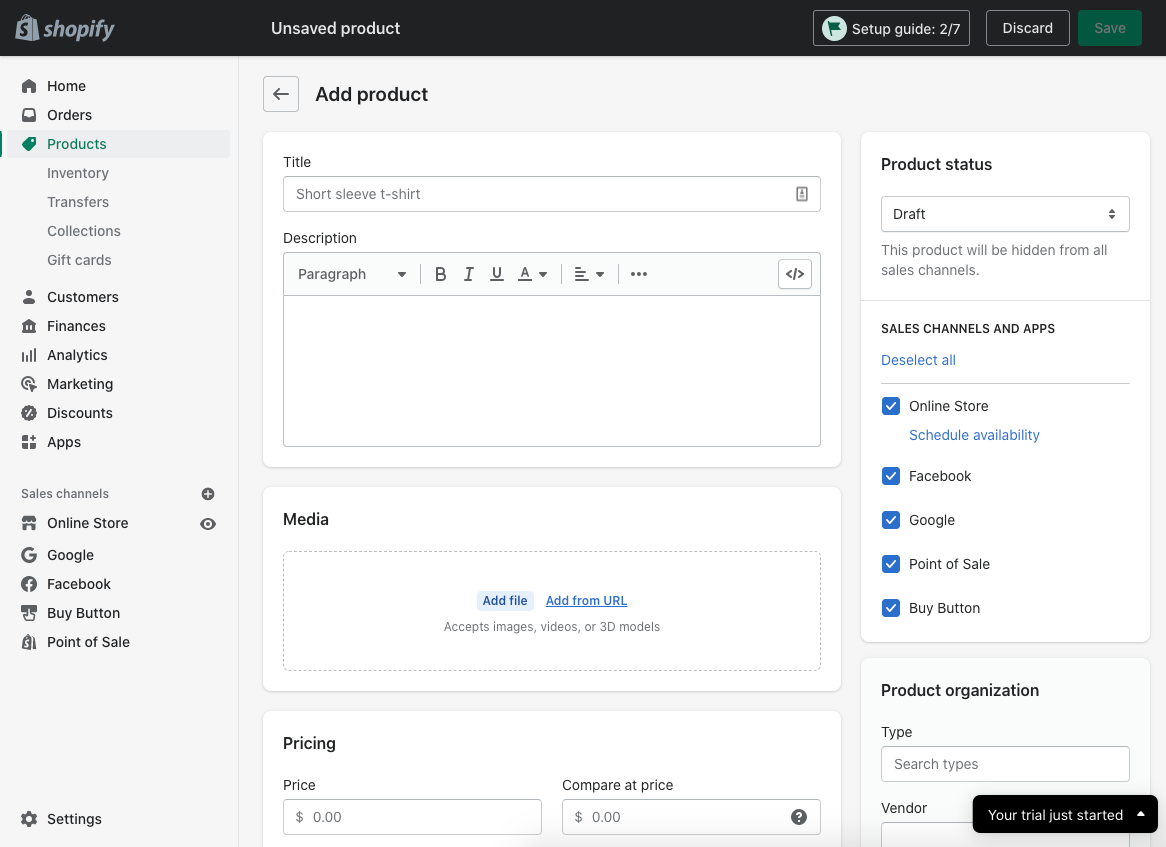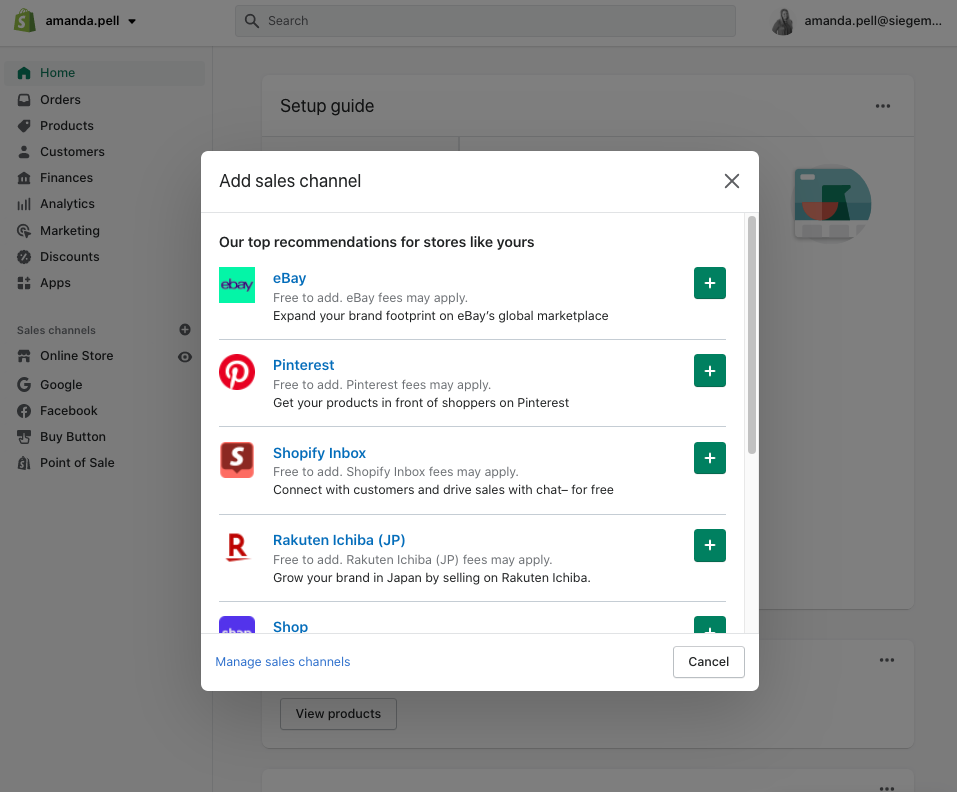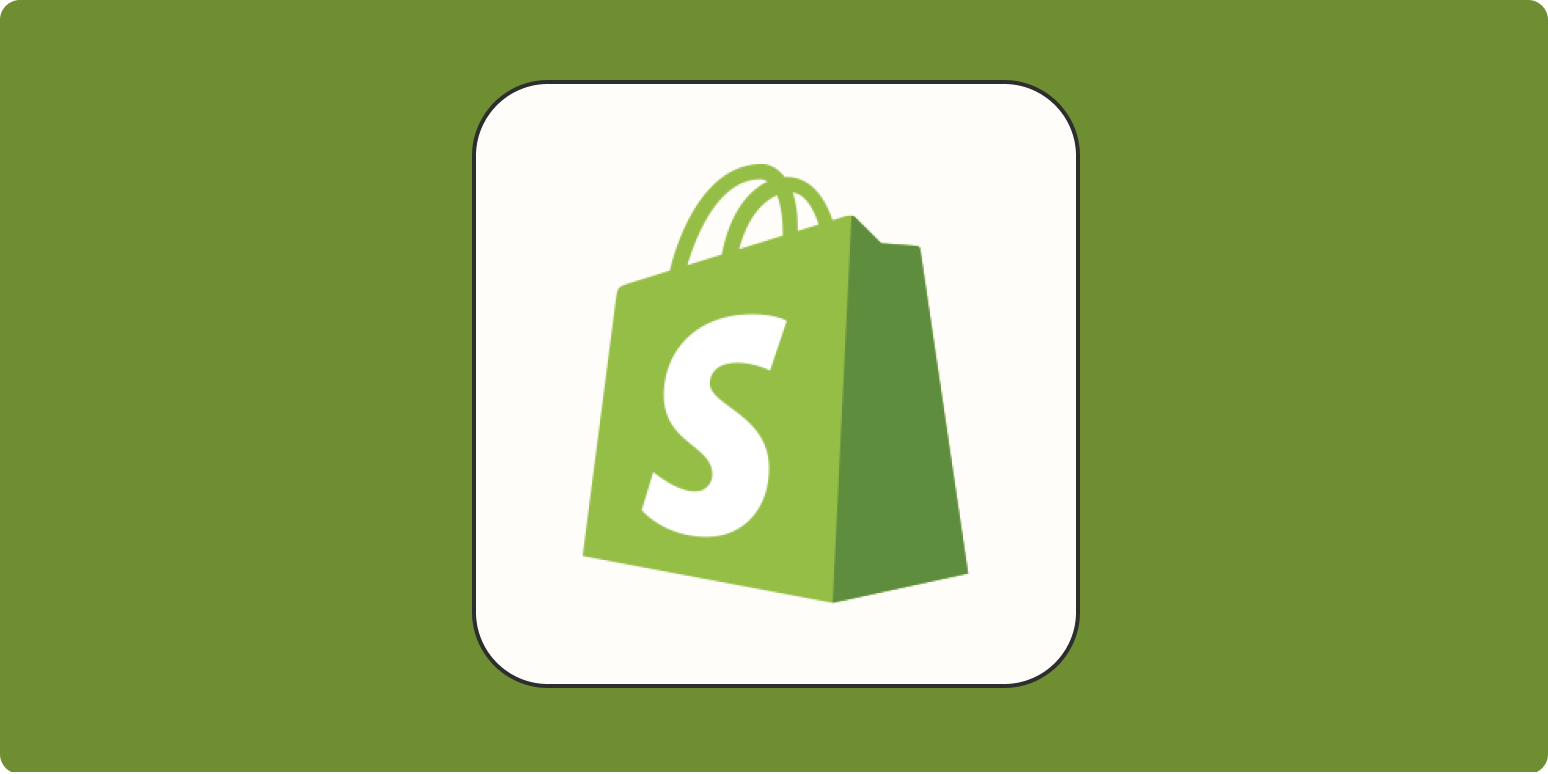Like anyone with an iPad and bills to pay, I’ve considered trying to land a passive income stream by setting up a dropshipping store to sell simple designs, stickers, and low-content books. I’ve even gone so far as setting up storefronts on a few different platforms to test out the different features and interfaces.
It’s thanks to eCommerce websites like Shopify that people like me can adopt this dabbler’s attitude toward the idea of starting a small business. With almost no overhead, the financial barrier to entry on eCommerce selling is low. And thanks to the simplicity of these platforms, the learning curve isn’t too steep, either.
If you’re setting up a digital storefront and ready to get started with Shopify, here’s how to get things up and running.
How to set up your Shopify store
1. Create your product listings
A store without products isn’t a store at all, which is why the first step that Shopify will prompt you to take after opening your account is to add your first products. You can add your products directly to your Shopify store, or you can browse the Shopify App Store to find the service you use to create or host your product listings and integrate it directly to your shop.
For example, I create my designs on Printify, so I can connect my two accounts and migrate my product images and descriptions instead of adding them manually.

Sellers can also add products to their Shopify store manually by navigating to the Products tab and opening a new product listing.
Whether you start by migrating products from other sites or you start from scratch, you’ll need to add the following information to each listing.
The basics
You can be as thorough or as sparse as you like with your product information, but at a minimum, each product listing will need a title, description, at least one product image, and a price. If you want to show the customer that a product is listed for a higher price on a different site, you can add a “compare at price” as well.
If a product has variants—for example, if it comes in multiple sizes or colors—you’ll need to add all of this information for each product variant.
Meta information
Once you have a good number of products listed on your site, you’ll want to make sure everything is well-organized and easily searchable. The way to do this is by adding meta information, like product type, tags, and (if you’re selling branded goods) original vendor brand.
Physical product information
If you’re selling physical products, you’ll need to add your product’s weight, so Shopify can calculate shipping prices. If you’re selling branded goods, or already have your products in a store, they’ll have a barcode (a UPC code or, if you’re selling books, an ISBN). You should also add a stock keeping unit, or SKU, to help keep track of your internal product stock and inventory. Finally, if you sell internationally, you’ll need a harmonized system code, which will be required in order for your product to make it through customs.

Additional options will also appear as you’re working if they apply to your product. If you add product variants, Shopify will add sub-listings for each so you can add basic info for each variant.
2. Organize your products into collections
Adding all of this detailed information to each product will make it easier to organize your listings into easy-to-navigate collections. Shopify uses collections to let you group your products, feature them on your homepage, and make it easier for customers to find items that go together.

Each collection will need a title and description at a minimum. Then, you can choose between adding new products to each collection manually or setting up automated product sorting so that Shopify adds new products to collections right away. If you choose the automated option, you’ll need to add conditions for Shopify to use to sort your collections (like price range, product type, and tags).
3. Choose a domain name
The default URL for your store will be your-name.myshopify.com, so you’ll need to choose a domain name—the address customers will use to visit your store—that’s simple and easy to remember.
You can either purchase a domain name via a third party like GoDaddy or Bluehost, or you can buy a domain directly through Shopify. In either case, a custom domain will likely run you $10-$20. Shopify has step-by-step instructions for setting up your domain that you can follow to set up a new URL.
4. Customize your Shopify storefront
Now for the fun part: with all of your product listings set up, you can customize your store’s look by editing your shop theme (under Online Store on your homepage menu). Shopify includes six default free themes, along with a Theme Store where you can choose from dozens of free or paid themes from designers around the world.

Shopify’s theme editor is similar to most website hosting platforms. It starts you off with a basic site structure that store owners can customize as much or as little as they like.
The default site has blocks like an image banner, site title, text, product collages, and a footer. You can select each one and add your own information, delete or move blocks around, and add new blocks by clicking the plus signs that appear between blocks.
At the bottom of the left-most menu column, select Theme Settings to open a new menu, where you can edit things like colors, fonts, currency format, buttons, and other site features.
5. Add key information for SEO
In the same way that you should add meta information to each product listing so that shoppers can easily search your site, you should also add meta information and tags to your shop as a whole so that it will show up in search engines.
From your dashboard, select Online Store and scroll down to Preferences. This will bring you to a page where you can add the title, meta description, and image you want to appear on search engines and social media. If you have Google Analytics or if you sell via Facebook, you can link those accounts here as well in order to track site and customer data.

How to manage your Shopify store
Your basic store is plenty to get started, with product listings, a customized theme, featured collections of products, and your domain name. Shopify will email you whenever you get a new order, and you could ship the orders to the address in that email.
To run an efficient, well-maintained store, though, you’ll want to put a bit more work into Shopify. Here are the tools you need to keep track of your sales, add more info and features to your store, and let your store take care of itself with automation.
Manage your orders
By now, you should have the Shopify menu down pat: you’ll hover over the left side of the screen, select the item, and then click the sub-item you want. To see your orders, select Order, and you’ll jump right to the Orders sub-page. You can open any order and see which orders are paid and which still need to be shipped.
Open your first order to ship, and look through the page. You’ll see the products ordered, order total, customer’s shipping address, and even a risk analysis where Shopify tries to detect if an order is fraudulent. You can add a comment or note on the order—perhaps to list something the customer said or to note which specific product you sent them—and can add tags to categorize that order. Then, click Continue to print a shipping label with pre-paid shipping from your postal service, or you can make a shipping label and mark the order as shipped.
Add extra pages
Your store will include a few pages by default: your store’s front page, a catalog of your products along with individual product pages, and perhaps an About page with details about your store. To create a more fulfilling shopping experience, you’ll need to flesh out your site with additional pages. (You can find these options on the left homepage menu under Online Store.)
Blog posts are perfect for sharing news or updates. If you’re looking to garner organic search traffic, this is where you’ll write content for SEO as well. Blog posts display in reverse chronological order with the newest post on top.
Pages, on the other hand, appear permanently in the top menu of your store. If you want to add things like contact forms, store hours and info, directions, and any other reference information, you should use Pages to do it.
Sell in more places
Your online store is a great place to sell products and put all your marketing efforts into one place. The only problem is, you’ll have to attract potential customers to your store. That’s tough—and sometimes it’s easier to put your products where customers already are.
That’s what makes selling products on marketplaces so appealing—and Shopify can help you do that while still managing everything through your main store site. Click the + icon beside Sales Channels in the Shopify menu, and you can add integrations for marketplaces, including eBay and Amazon, along with social networks like Twitter, Facebook, and Pinterest. You can even add Shopify to Messenger to chat with customers and close sales right inside of Facebook Messenger chat.

Add features with apps and integrations
Shopify includes everything you need to get a basic store up and running within its setup guide and homepage menu, but there are a lot of other things you can do with your store by adding app integrations from the Shopify App Store.
Here are a few apps you might want to install as your store gains momentum:
-
SEO tools like Yoast SEO, Schema Plus, or Swift
-
Automatic language and currency translators like Transcy, T Lab, or LangShop
-
Additional site features like product reviews, email opt-in popups, and “customers also bought” recommendations
-
Invoicing and accounting platforms like QuickBooks or Xero
-
Report generators for sales, inventory, and customer data
-
Email marketing platforms like Mailchimp or Sendinblue
Shopify offers over 7,000 different integrations, but there are some notable exceptions like Discord, ConvertKit, Keap, Google Workspace, Asana, and Trello. For some apps, like Slack, you can find third-party integrations designed to integrate the two platforms, but these are hit-and-miss. If you use a platform that isn’t natively supported by Shopify, you can always use Zapier’s Shopify integrations to connect it to thousands of other apps.
Here are some ideas to get you started:
This article was originally published in August 2018 by Matthew Guay.
[adsanity_group align=’alignnone’ num_ads=1 num_columns=1 group_ids=’15192′]
Need Any Technology Assistance? Call Pursho @ 0731-6725516




